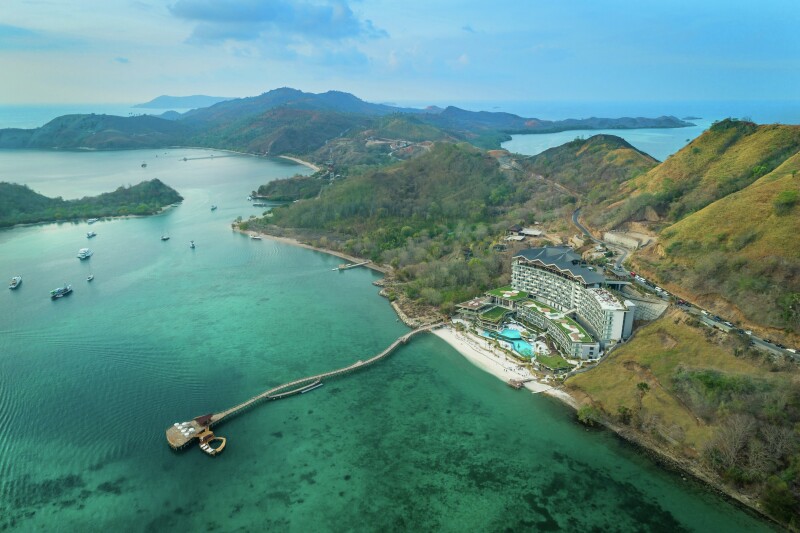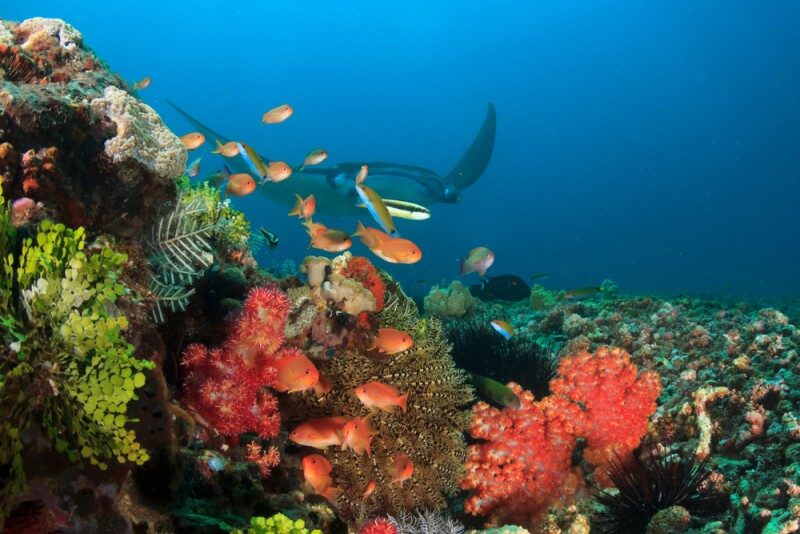As soon as I stepped off the boat onto Komodo Island, I noticed a large lizard stretched across the dock. It was big—maybe five feet long. The park ranger told us it was a baby Komodo dragon. As we hiked farther into the park, the ranger pointed out large tracks with deep claw marks scratched into the dirt. And then we saw another, straight ahead of us, staring: It looked about nine feet in length, easily weighing over 200 pounds. Its tail was the width of my body, maybe even thicker. This gigantic, scaly creature with a long snout lined with pointy teeth and sharp claws protruding from its humongous feet was exactly what I had pictured, minus the fire-breathing.
Komodo dragons are the world’s largest species of lizard, and they can reach up to 10 feet in length and weigh at least 300 pounds. The only way to see these predators in the wild is to visit Komodo National Park. And now that the area has a new luxury hotel, people heading to see the islands will have a more comfortable place to stay nearby. Here’s the scoop on how to get there, what to do, and what to expect from the rapidly developing region.
It’s becoming easier to get there
Only a one-hour flight from Bali, Komodo National Park consists of the main islands of Padar, Rinca, Komodo, and Gili Motang, as well as other smaller islands. The Labuan Bajo airport on nearby Flores has increased its domestic flights over the past few years and hopes to become an international airport in 2019 as it undergoes construction to expand. Upon landing, hop in a taxi to your hotel or rent a motorbike. Most accommodations are within walking distance to restaurants and the marina where you can hire boats to explore other islands.

Komodo dragons go for a stroll.
Photo by Dwi Prayoga/Shutterstock.com
The nature is incredible
In addition to the chance to spot the closest thing to a living dinosaur, Komodo National Park, a UNESCO World Heritage site, includes one of the world’s richest marine environments. Scuba dive or snorkel to see coral reefs that harbor more than 1,000 species of fish and at least 14 species of whales, dolphins, and sea turtles.
Other popular excursions include visits to the pink-, black-, and white-sand beaches on Padar Island, seeing the large bats (sometimes called flying foxes) and mangroves on Kalong Island, and viewing Flores’s famous spider web rice terrace from above.

Ayana Komodo Resort, Waecicu Beach in Indonesia
Courtesy of Ayana Komodo Resort, Waecicu Beach
There’s a swanky new place to stay
The island of Labuan Bajo is one of the closest places to the national park to stay overnight. In September, it got its first luxury resort: the 205-room five-star Ayana Komodo Resort, Waecicu Beach. With the opening of Ayana Komodo, visitors will have access to unprecedented luxury in Labuan Bajo for the first time.
The resort includes three swimming pools, a spa, fitness center, and seven restaurants and bars. Perhaps most importantly, Ayana has a private pier and its own boats to facilitate trips to surrounding islands. The resort’s crown jewel is the Ayana Lako di’a, the resort’s very own luxurious 54-meter traditional Phinisi sailing boat with nine luxury cabins for taking multi-night trips around the islands.
In addition to the Lako di’a, Ayana offers “glass bottom boat tours and VIP trips on board the ‘Bond-style’ speedboat,” says Fernando Arroyo, general manager, Ayana Komodo Resort, Waecicu Beach.
For travelers who prefer to stay off the coast of Flores, small options include Angel Island Eco Resort and Kanawa Island Resort.

Marine life abounds underwater at Komodo National Park.
Photo by Rich Carey/Shutterstock.com
You can responsibly explore a part of Indonesia—beyond Bali
With severe over-tourism an issue in nearby Bali, Ayana Komodo’s opening could help pull tourists to other parts of Indonesia that have as much to offer as the Eat, Pray, Love destination.
“I think the resort and the increase in awareness will undoubtedly help Bali,” says Arroyo. “The islands are a wonderful complement to each other and as long as tourism is managed properly with the tourism industry working in unity, I don’t believe [Komodo National Park] is in danger.”
New builds and park concessions have often been contentious with local villagers and eco-purists. Ayana took careful consideration of these issues when it was constructed, taking measures to offer better ocean protection with the assistance of its on-site marine biologist Jinjing Yan, as well as park conservation. The resort will also donate US$1 from every room sold to Komodo National Park, which will help with the increasing costs that will surely come along with the increase in visitors.
In April, the Indonesian president declared Labuan Bajo a Tourism Authority in order to manage both the accelerating numbers of tourists and to protect the dragons and marine wildlife. And in August, after a fire broke out on Gili Lawa from a discarded cigarette, the Environment and Forestry Ministry’s director general for natural resources and ecosystems told the Jakarta Post that they are considering capping the monthly number of visitors to the national park at 5,000 (currently it’s at about 10,000). Infrastructure developments, like construction of new pedestrian walkways and bridges in Labuan Bajo, and placing mooring buoys around the national park to protect coral reefs from boats, are already underway.
The number of travelers arriving to the islands will increase with the new resort, says Chris Hardy, Intrepid Travel’s PEAK DMC Indonesia country manager. He doesn’t see it as all bad though, as long as the park is prepared.
“The authorities will need to effectively manage the influx of visitors. The opening of the hotel will be great in the sense that it will offer more employment to local people, and more customers to support local vendors,” Hardy says. “It will help spread some of the wealth to communities not currently benefiting from the tourism boom in Bali.”
>>Next: Yes, You Can Go to Madagascar—and Not Just for the Lemurs











